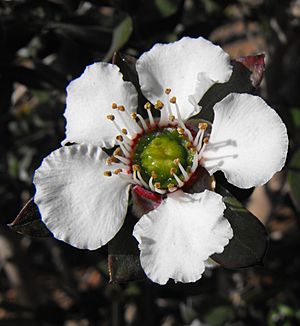Leptospermum turbinatum facts for kids
Quick facts for kids Shiny tea-tree |
|
|---|---|
 |
|
| Cultivated specimen in California | |
| Scientific classification | |
| Genus: |
Leptospermum
|
| Species: |
turbinatum
|
| Synonyms | |
|
Leptospermum nitidum auct. non Hook.f.: Willis, J.H. (1973) |
|
The Shiny tea-tree (Leptospermum turbinatum) is a special type of shrub. It grows only in the Grampians National Park and nearby mountains in Victoria, Australia. This plant is known for its shiny leaves and pretty white flowers. It's a spreading shrub, which means it grows wide rather than very tall.
Contents
What Does the Shiny Tea-Tree Look Like?
The shiny tea-tree is a spreading shrub that usually grows to be about 1 to 3 meters (3 to 10 feet) tall. It has thin, rough bark. Its youngest stems are covered with short, soft hairs.
Leaves and Flowers
The leaves of the shiny tea-tree smell nice. They are shaped like an oval or a spear, with the narrower end at the bottom. Each leaf is about 10 to 25 millimeters (0.4 to 1 inch) long and 3 to 8 millimeters (0.1 to 0.3 inches) wide. They have a sharp point at the tip and narrow down to a short stalk called a petiole.
The flowers are white and quite large, about 25 millimeters (1 inch) wide. They grow one by one on leafy side branches. The base of the flower, called the floral cup, is covered with long, silky hairs. It's about 3 millimeters long and tapers to a short stem called a pedicel. The sepals, which are like small leaves protecting the bud, are also hairy and triangular, about 5 to 7 millimeters long. There are five petals, each about 12 millimeters long. The stamens, which hold the pollen, are about 5 millimeters long.
When it Flowers and Fruits
The shiny tea-tree mainly flowers in November. After flowering, it produces a fruit called a capsule. This capsule is about 7 to 11 millimeters wide. The remains of the sepals stay attached to the fruit. What's interesting is that these fruits stay on the plant even after they are fully grown.
How the Shiny Tea-Tree Got its Name
This plant was officially described for the first time in 1989 by a scientist named Joy Thompson. She wrote about it in a science journal called Telopea. Her description was based on plants collected in 1952 from Mackays Peak in the Serra Range, which is part of the Grampians National Park.
The second part of its scientific name, turbinatum, describes the shape of its fruit. It refers to the fruit's top-like or turban-like shape.
Where the Shiny Tea-Tree Lives
The shiny tea-tree grows in special places within the Grampians National Park and nearby mountains. You can find it on rocky sandstone slopes and close to granite outcrops. This plant is endemic to this area, meaning it naturally grows nowhere else in the world!

